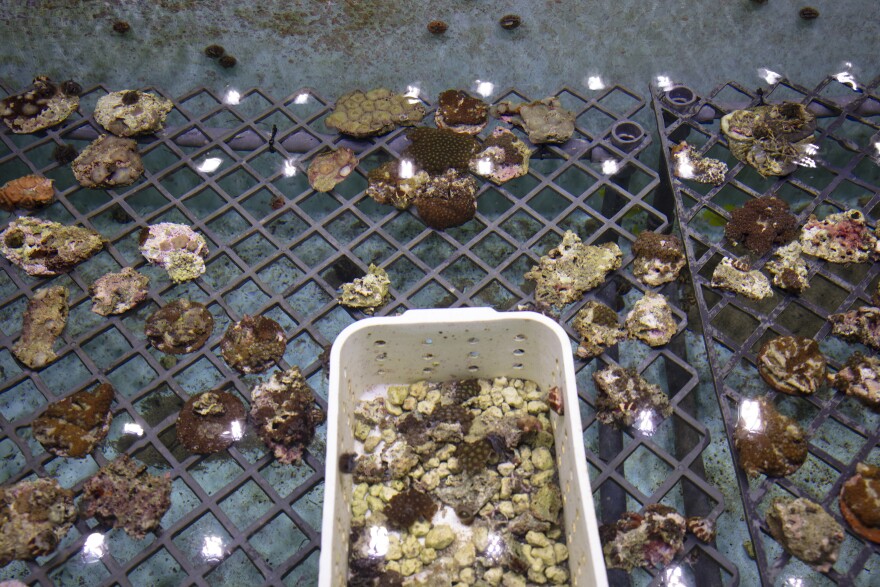By: Youheng Zhong
When federal wildlife inspectors search for illegally trafficked animal goods, you might think that they’d be looking out for exotic birds or elephant ivory. But, that isn’t all they look for, as one of the most frequently seized creatures at American ports of entry might surprise you: it’s coral.
Corals are invertebrates that live in colonies made up of genetically identical polyps: tiny sac-like animals. These polyps are small, ranging in size from a few millimeters tall to a couple centimeters. As these polyps grow, they each excrete an exoskeleton for protection usually during their growth phase. When they die, they leave that exoskeleton behind, and over many generations, the exoskeletons pile up, thus creating a coral. Different-shaped polyps leave behind different-shaped exoskeletons corresponding to different species of coral and producing the colorful coral reefs we know today.
Because of how long it takes for a singular coral to grow, coral is highly valued in many markets. For example, coral jewelry has a high market value in many parts of Asia, having a wholesale market value “between $50 million and $60 million per year, with the value of each piece of jewelry based on the color, size, and quality of the coral”(nytimes). Because of how valued coral jewelry is, coral has been harvested and traded for centuries in Asia. People also put live coral on the market. But corals are often rare and hard to find, and coral traffickers bank on that. After chiseling the coral off of reefs, they pack them into small baggies of seawater, box them up, and ship them around the world to unsuspecting aquarium enthusiasts who are eager to pay big money to get their hands on a rare or endangered species of coral imported for their aquariums. And while most coral is shipped into the US legally, there is a growing number of shipments being intercepted that contain coral species or quantities restricted or banned from trade. A report from the United Nations Office on Drugs and Crime found that corals were the third-most confiscated wildlife group globally between 1999 and 2018, accounting for 14.6 percent of all seizures.
“The US is the primary market for marine corals,” says Ashley Skeen, a wildlife inspector. “We’re number one.”
Coral trafficking isn’t the only way coral reefs are being harmed. Coral is extremely sensitive, so a few degrees of temperature change in the seawater can kill off the coral and much of the ecosystem that depends on the coral. And that ecosystem is hardly small: “Coral reefs support more species per unit area than any other marine environment, including about 4,000 species of fish, 800 species of hard corals and hundreds of other species. Scientists estimate that there may be millions of undiscovered species of organisms living in and around reefs” (NOAA). In addition to climate change, coral are vulnerable to disease outbreaks, bleaching events, ocean acidification, warming seas, and sediment and/or nutrient runoff from human activities.
However, all hope isn’t lost! There are still ways we can help coral reefs and climate change as individuals. When you go diving and snorkeling in coral reefs, don’t touch the coral or anchor boats on them. Coral are delicate, and instead you can opt for sandy bottoms or moorings. To protect from the sun, use reef-friendly sunscreen. These sunscreens don’t contain oxybenzone, octinoxate and octocrylene, which can harm corals. And even if you aren’t going to a coral reef, still use those sunscreens. All the water in the oceans circulate around the globe, and often pool wastewater goes in a stream or river that can make its way to an ocean. You should also dispose of your trash properly so it doesn’t make its way into the ocean. These are all just a few ways to help protect corals, so tourists can continue to explore their ecosystem for generations to come.
Sources:
https://www.nytimes.com/2013/11/13/fashion/reefs-suffer-amid-surging-demand-for-jewelry-coral.html?_r=0
https://en.wikipedia.org/wiki/Coral_poaching#cite_note-New_York_Times-1
https://www.nytimes.com/2024/06/24/science/coral-reef-trafficking-aquariums.html











